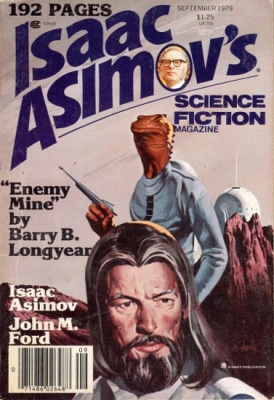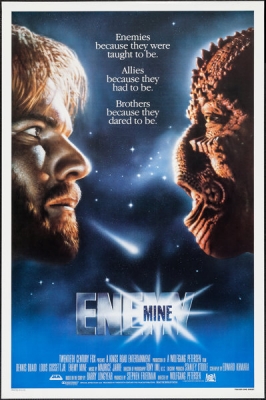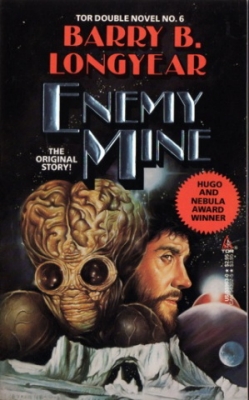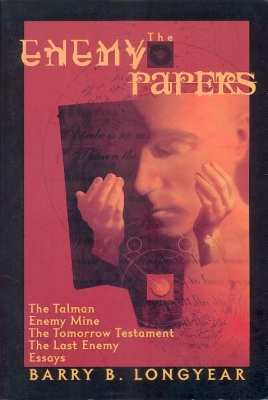The Golden Age of Science Fiction: “Enemy Mine,” by Barry B. Longyear

The Best Novella category was not one of the original Hugo categories in 1953. I twas introduced in 1968, when it was won by Philip José Farmer for “Riders of the Purple Wage” and Anne McCaffrey for “Weyr Search.” Since then, some version of the award has been a constant, with the exception of 1958. In 1980, the awards were presented at Noreascon II in Boston.
The Nebula Award was created by the Science Fiction Writers of America (SFWA) and first presented in 1966, when the award for Best Novella was won by Brian W. Aldiss for “The Saliva Tree” and Roger Zelazny for “He Who Shapes.” The award has been given annually since then.
The Locus Awards were established in 1972 and presented by Locus Magazine based on a poll of its readers. In more recent years, the poll has been opened up to on-line readers, although subscribers’ votes have been given extra weight. At various times the award has been presented at Westercon and, more recently, at a weekend sponsored by Locus at the Science Fiction Museum (now MoPop) in Seattle. The Best Book Novella Award dates back to 1974, when the short fiction awards were split into Short Fiction and Novella lengths. Frederick Pohl won the first award. In 1980. The Locus Poll received 854 responses.
In January, I wrote about Barry B. Longyear, the winner of the John W. Campbell Award in 1980 and explored the vast amount of fiction he published in 1978 and 1979. At that time, I dismissed his biggest hit with a single line, “His breakout story, of course, was “Enemy Mine,” which will be covered in more depth in the article on that novella’s various awards for the year.” Now is come the time to discuss that story.
The novella tells the story of human Willis Davidge and the alien Drac, Jeriba Shigan. After Davidge damages Jeriba’s spaceship, Jeriba managed to maneuver into Davidge, forcing both to crash land on the planet Fyrine IV. The two quickly realize that despite their hostility and indoctrination, they needed to work together in order to survive. Never really friends, they came to rely on each other and spent their long hours learning about each other’s cultures.
When the Jeriba died giving birth to its child, Davidge used the lessons he had learned from the dead Drac to raise the child with an understanding of its own culture in a world where the only civilization was what Davidge created. Eventually, Davidge and Zammis are rescued and separated, with each being returned to their own planet.
While Longyear could have ended the story with their separation and return to their own cultures, although Zammis had never directly experienced its own culture, he instead continues to follow the characters. Although the war with the Drac is over, Davidge is seen as a Drac sympathizer and human society has no place for him. He eventually travels to the Drac home world, where he discovers that Jeriba and Zammis belong to a much more important family than he had realized, although Zammis has been unpersoned due to his strange upbringing. Davidge works to get Zammis recognized and looks for a place in the universe that won’t reject the two of them.
Longyear is on record as seeing “Enemy Mine” as a story related to the Israeli-Palestinian conflict, although it clearly can be mapped to just about any conflict in which the enemy is dehumanized. Viewed in the context of 2019, the removal of Zammis to a culture which might provide him with his roots, but to a place where he has never visited and doesn’t know anyone, lends the story a new pertinence.
Over the years, Longyear had expanded “Enemy Mine” and written sequels to it, eventually collecting all of the stories about Davidge and the Drac in The Enemy Papers, published in 1998 by White Wolf, which includes the original story, The Tomorrow Testament, The Last Enemy, excepts from the Talman, the Drac’s philosophy book that plays a major role in “Enemy Mine,” and three essays by Longyear.
“Enemy Mine” beat out Hilbert Schenck’s “The Battle of Abaco Reefs,” “Ker-Plop,” by Ted Reynolds, Donald Kingsbury’s “The Moon Goddess and the Son,” and Orson Scott Card’s “Songhouse” to take home the Hugo Award for Best Novella.
Other Nebula Award for Best Novella nominees included Schenck’s “The Battle of Abaco Reefs,” Joan D. Vinge’s “Fireship,” Frederik Pohl’s “Mars Masked,” Richard Wilson’s “The Story Writer,” and Samuel R. Delany’s “The Tale of Gorgik.”
The other top five novellas for the Locus Award included (in order of finishing) “Songhouse” by Card, “Palely Loitering” by Christopher Priest, “Mars Masked” by Pohl, and “The Battle of Abaco Reefs” by Schenck.
Only Longyear’s “Enemy Mine” and Schenck’s “The Battle of Abaco Reefs appeared on all three ballots. Card and Pohl both appeared on two of them.
 Steven H Silver is a sixteen-time Hugo Award nominee and was the publisher of the Hugo-nominated fanzine Argentus as well as the editor and publisher of ISFiC Press for 8 years. He has also edited books for DAW, NESFA Press, and ZNB. He began publishing short fiction in 2008 and his most recently published story is “Webinar: Web Sites” in The Tangled Web. His most recent anthology, Alternate Peace was published in June. Steven has chaired the first Midwest Construction, Windycon three times, and the SFWA Nebula Conference 6 times, as well as serving as the Event Coordinator for SFWA. He was programming chair for Chicon 2000 and Vice Chair of Chicon 7.
Steven H Silver is a sixteen-time Hugo Award nominee and was the publisher of the Hugo-nominated fanzine Argentus as well as the editor and publisher of ISFiC Press for 8 years. He has also edited books for DAW, NESFA Press, and ZNB. He began publishing short fiction in 2008 and his most recently published story is “Webinar: Web Sites” in The Tangled Web. His most recent anthology, Alternate Peace was published in June. Steven has chaired the first Midwest Construction, Windycon three times, and the SFWA Nebula Conference 6 times, as well as serving as the Event Coordinator for SFWA. He was programming chair for Chicon 2000 and Vice Chair of Chicon 7.


